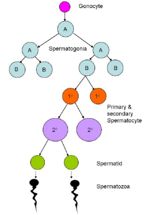Difference between revisions of "Spermatogenesis and Spermiation - Anatomy & Physiology"
RebekahMCB (talk | contribs) |
RebekahMCB (talk | contribs) |
||
| Line 8: | Line 8: | ||
*Differentiation phase / spermiogenesis - spermatids | *Differentiation phase / spermiogenesis - spermatids | ||
| − | ==The | + | |
| + | [[Image:spermatogenesis.jpg|thumb|right|150px|Spermatogenesis Copyright Amy Cartmel 2008]] | ||
| + | |||
| + | ==The seminiferous tubule== | ||
[[Image:spermatogenesis.jpg|thumb|right|150px|Spermatogenesis Copyright Amy Cartmel 2008]] | [[Image:spermatogenesis.jpg|thumb|right|150px|Spermatogenesis Copyright Amy Cartmel 2008]] | ||
| − | + | The seminiferous tubules are the site of spermatogenesis. The 2 main cell types within the tubules which are involved in spermatogenesis are the germ cells, which will develop into sperm, and somatic cells known as Sertoli cells, which nuture the germ cells throughout the development process. | |
| − | + | ||
| − | + | As the germ cells progress through their stages of development they move slowly from the basement membrane of the tubules through the tight junction of the Sertoli cells into the tubular lumen. | |
| − | + | ||
| − | + | ==The proliferation phase== | |
| − | + | ||
| + | The spermatogonia go through several divisions | ||
==Hormonal Control of Spermatogenesis== | ==Hormonal Control of Spermatogenesis== | ||
Revision as of 12:50, 28 April 2012
| This article has been peer reviewed but is awaiting expert review. If you would like to help with this, please see more information about expert reviewing. |
Introduction
Unlike the female production of gametes which occurs entirely before birth with gamete maturation occurring in a pulsatile fashion after puberty, male individuals produce gametes continuously from puberty onwards for the rest of their reproductive lives and the release of the gametes is constant. Spermatogenesis is the process of the gradual transformation of germ cells into spermatozoa. It occurs mainly within the seminiferous tubules of the testes and can be divided into three phases, each of which is associated with different germ cell types:
- Proliferative phase - spermatogonia
- Meiotic phase - spermatocytes
- Differentiation phase / spermiogenesis - spermatids
The seminiferous tubule
The seminiferous tubules are the site of spermatogenesis. The 2 main cell types within the tubules which are involved in spermatogenesis are the germ cells, which will develop into sperm, and somatic cells known as Sertoli cells, which nuture the germ cells throughout the development process.
As the germ cells progress through their stages of development they move slowly from the basement membrane of the tubules through the tight junction of the Sertoli cells into the tubular lumen.
The proliferation phase
The spermatogonia go through several divisions
Hormonal Control of Spermatogenesis
The production of sperm is controlled by hormones influencing sertoli cells rather than sperm cells directly. Hormonal control is via the two gonadotrophins luteinising hormone (LH) and follicle-stimulating hormone (FSH).
- LH acts on the interstitial leydig cells stimulating them to produce the androgen testosterone.
- FSH acts on the sertoli cells within the seminipherous tubules stimulating production of Androgen Binding Protein as well as Inhibin
| Spermatogenesis and Spermiation - Anatomy & Physiology Learning Resources | |
|---|---|
 Selection of relevant videos |
Dissection of the equine testicle |
 Selection of relevant PowerPoint tutorials |
Histology of the Male reproductive tract |
